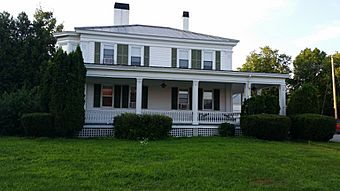Bigelow-Page House facts for kids
Quick facts for kids |
|
|
Bigelow-Page House
|
|
 |
|
| Location | 20 High St., Skowhegan, Maine |
|---|---|
| Area | less than one acre |
| Built | 1846 |
| Architect | Joseph Bigelow |
| Architectural style | Greek Revival |
| NRHP reference No. | 88000395 |
| Added to NRHP | April 20, 1988 |
The Bigelow-Page House is a historic home located at 20 High Street in Skowhegan, Maine, United States. It was built between 1846 and 1847. This large, two-story wooden house is a great example of Greek Revival architecture. It was one of the first important projects by a well-known local builder, Joseph Bigelow. The house was listed on the National Register of Historic Places in 1988. This means it is recognized as a special place in American history.
Contents
Discovering the Bigelow-Page House
What Does the House Look Like?
The main part of the Bigelow-Page House is a large, almost square, two-story building. It is made of wood and has a hip roof. You can see two brick chimneys inside the house. Several smaller sections, called ells, extend from the back. These connect the main house to a barn with a cupola on its roof.
A porch with a hip roof wraps around two sides of the main house. It is held up by square posts with panels. The corners of the main house have special decorations called pilasters. A wide, flat band, known as an entablature, goes all around the house below the roof. The first ell is a big, two-story section with features from the Italianate style.
Inside the Bigelow-Page House
The inside of the house has many different styles. This shows the changing architectural trends over time. You can find original Greek Revival designs. There is also an Italianate arched fireplace mantel. A Colonial Revival bay window was added later. These different styles make the house unique.
Who Built the Bigelow-Page House?
This house was built in 1846-1847 by Joseph Bigelow for his own family. Joseph Bigelow (1804–1883) was a very skilled builder. He was known for his high-quality work in the area. Before building this house, he had already built a church in Bloomfield, Maine. He also built the Isaac Farrar Mansion in Bangor, Maine. Bigelow is also known for building another beautiful Greek Revival house in Skowhegan, Maine. This was the Gov. Abner Coburn House.
How the House Changed Hands
In 1853, Joseph Bigelow traded houses with a lumberman named Samuel Robinson. Later, in 1893, Edward Page bought the house. The Page family made some changes to the house. They added the Colonial Revival features you can see today.



